1980 Italian Grand Prix race report

Carlos Reutemann on his way to 3rd in his Williams
Motorsport Images
Another win for Piquet
Imola, September 14th
SOME TWO years ago there was a lot of dissatisfaction with the Monza Autodromo as the scene of the Italian Grand Prix, even though it was the traditional home of the race. Negotiations were opened to hold the Grand Prix at Imola, to the east of Bologna in the Province of Emilia Romagna, but the circuit was not ready to last year saw the Italian GP still at Monza. The Automobile Club of Milan did a fine job of work in restructuring the whole paddock area and improving the circuit so that after the 1979 event a lot of people began to wonder why the plans were going ahead to run the event at Imola in 1980. Plans to settle the deal were too far advanced to be changed so this year the Italian Grand Prix took place at the Imola Autodromo which is called the Dino Ferrari circuit, after the long-dead son of Enzo Ferrari, and the Automobile Club of Bologna took over the organisation. Apart from a new chicane that was too tight, the whole event went off very well and everyone is now faced with the problem of where to run the Italian Grand Prix in future. Whatever happens, Monza is the true home of the Italian Grand Prix, but nonetheless Imola is well capable of handling a big Formula One event.
Facilities in the way of pits, paddock and administration buildings are more than satisfactory and the circuit is interesting in that it is fast, goes up hill and down hill, but does have too many artificial wiggles to slow cars down. It is probably not appreciated that the circuit was originally on ordinary public roads but over the years the AC of Bologna have acquired the land and fenced the whole thing in to make a permanent Autodromo. It’s most unusual feature is that it runs in an anti-clockwise direction.
Qualifying
Testing on Friday morning was delayed as Emilian fog had grounded the medical emergency helicopter before it could set off for the circuit. Some of the Alfa Romeo team had arrived by a private helicopter from their hotel near Bologna and it had had an accident on the landing pad behind the paddock and put some of the mechanics in hospital. Meanwhile Brambilla and Engineer Chiti had arrived by road and had had an accident with a lorry and put the lorry-driver into hospital. The more important teams had already done some practice on the circuit, while Ferrari and Alfa Romeo have used the circuit for testing. Interest was high on Friday morning as the turbo-charged 1½-litre V6 Ferrari was expected, but in fact it did not arrive until late in the afternoon, long after Friday’s activity was finished. Surprise of the day was the performance by the Renaults for though they had done Michelin tyre tests on the circuit it was felt that the chicanes with their sharp corners (one actually is a first gear affair) would not suit the French cars. It is becoming increasingly clear that everything suits the Renaults these days, there being few serious handicaps to the turbo-charged 1½-litres.
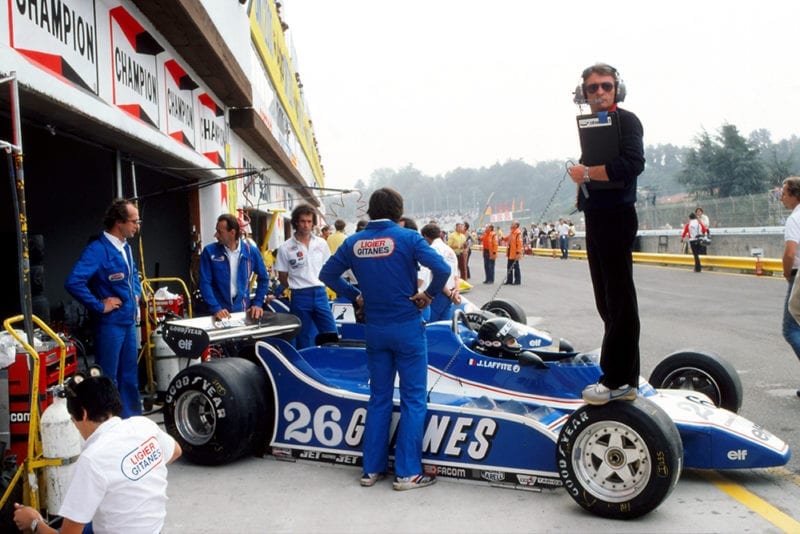
Designer Gerard Ducarouge stands on the wheel of Jacques Laffite’s Ligier
Motorsport Images
During the morning there were the inevitable alarums and excursions, some tiresome, some frustrating and some disastrous. Fittipaldi set off in F8/2 and only got half way round his first lap when the throttle slides on his Cosworth DV jammed shut and prevented him even getting back to the pits slowly. Pironi was driving his Ligier in real anger, doing heroic things under breaking downhill and traversing some of the bumpier corners in terrific power-slides, yet his lap times were way off the general pace. Nigel Mansell was warming-up in the Lotus 81/B and moved over to let a faster car through only to get on the loose stuff at the edge of the track and slide off into the barriers. Damage was minimal, but he had to abandon the car and some while later Manfred Winkelhock, replacing Jochen Mass in the Arrows team, did the same thing and collided with the abandoned Lotus, resulting in two unrepairable cars and both drivers missing the timed afternoon practice. The Osella team started using their new car, but not for long, as the Cosworth engine blew up and Brambilla’s Alfa Romeo shook its rear aerofoil off. Alan Jones had engine trouble on his Williams, took over the spare and that had engine trouble as well no that there was plenty of work for everyone to do.
The message from the morning test-session was that the Renaults were going to be the pace-setters, with Giacomelli and his V12 Alfa Romeo on terrific form and improving all the time, so that the best Cosworth powered car looked like being in fourth place. The Williams team were vying for this dubious honour, with Nelson Piquet in his Brabham right behind them. The Ligiers were right off the pace and as is becoming more and more obvious the Goodyear tyre technology seems to be suited to, or even produced for, the Williams and Brabham teams rather than for the French cars.
Sure enough the Renaults set the pace in the timed hour, looking smooth and neat and not at all exciting, compared to some other cars that were being driven spectacularly in their efforts to keep up. Italian national pride was overcoming local enthusiasm and Giacomelli and the Alfa Romeo were being cheered everywhere, especially when “little Bruno” got between the Renaults on the lap time lists. Jabouille had set the fastest lap in 1m. 34.339 sec. on his third lap, and then more or less sat back, though he did do ten more laps during the afternoon, whereas Arnoux did a total of 21 laps, making his best in 1 min. 34.759 sec. on his 17th lap. Giacomelli tried desperately to keep with Arnoux, but just could not get into the 1.34 bracket, though he came close with 1 min. 35.082 sec. which gave him third place ahead of all the Cosworth powered cars and both Ferraris. The Cosworth battle ended with Jones ahead of Piquet, with Reutemann very close behind, all in the 1.35 bracket, while Villeneuve led the rest in his Ferrari T5 though he was eagerly awaiting the arrival of the new turbo-charged Ferrari. Neither Mansell nor Winkelhock went out in the timed hour and the two Ensigns were at the bottom of the list, the usual system operating whereby only 24 of the 28 entries could qualify for the starting grid.
Although the Imola circuit has a respectable average speed, of over 117 m.p.h., there are lots of sharp corners which should have been anathema to the turbo-charged Renaults, but they seemed to cope remarkably well, and they were having no problems with their Michelin tyres, just as Alfa Romeo were quite happy with their Goodyear tyres, and it did not pass without notice that the first three places were taken by manufacturers cars and the first “home-built” special was fourth. Brakes were giving everyone a worrying time, not because they were being unduly hard anywhere, like at Zandvoort at the end of the long straight, but they were being used all the time with very little distance between applications to allow them to cool down. The technicians from Ferodo and AP-Lockheed were in continual demand, especially by Renault for the little 1½-litre engine doesn’t help on retardation like a 3-litre Cosworth on the over-run. After most people had gone home on Friday afternoon one of the old Ferrari transporters arrived with the turbo-charged 126C inside.
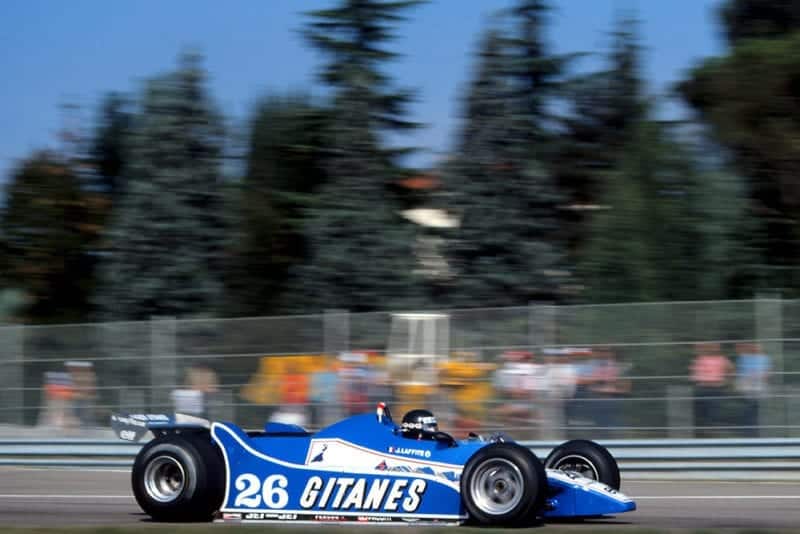
Once on track, Laffite could only manage 20th on the grid
Motorsport Images
Before the Saturday morning test session began the turbo-charged Ferrari was naturally the centre of attention and though it was the second one built it was still in the nature of a travelling test-bed; at least that is what it looked like, even though everything was newly designed, including the gearbox/final drive unit and all the suspension. When the engine was started we realized we were entering a new era in Ferrari history with an entirely new noise issuing from the short exhaust pipes. Needless to say it was Villeneuve who was to drive the car and during the morning we had a taste of 1981 when the two Renaults went by closely followed by the turbo Ferrari. At the beginning of the pit straight there is a sharp right-hand corner, so acceleration counts from here on. Longines had their speed-meter set up for the Ferrari team at the head of the pit wall and the T4 Ferrari flat-12 of Scheckter was recording 210 k.p.h. as it went through the speed trap, the Renaults recorded 21 k.p.h., the Alfa Romeo of Giacomelli was also on 214 k.p.h., while most of the Cosworth cars around 210 k.p.h. Villeneuve’s first lap showed 222 k.p.h., then 223 k.p.h., then 219 k.p.h. so clearly the turbo-charged 1½-litre V6 had power. It’s throttle response was not as good as the Renaults, but even so Villeneuve got down to 1 min. 36.628 sec. compared to his best T5 lap of 1 min. 36.350 sec., which was not a bad start for the first public appearance of the new Ferrari turbo-car.
In other parts of the pit lane there was much activity, Jones had a tiresome misfire on the spare Williams car, Jarier had a big moment out on the circuit when a tyre failed on his Tyrrell, there was a strong smell of Ferodo from some cars, Giacomelli was still fast with the Alfa Romeo but Renault were concentrating on tyre and brake pad wear as well as fuel consumption because the weather was getting very warm and 60 laps round the Imola circuit was going to call for careful calculations. Nigel Mansell was being allowed to run Andretti’s spare Lotus car, 81/2 and Winkelhock was in the spare Arrows preparing for the final hour of qualifying which was going to see the slowest four left out of the race.
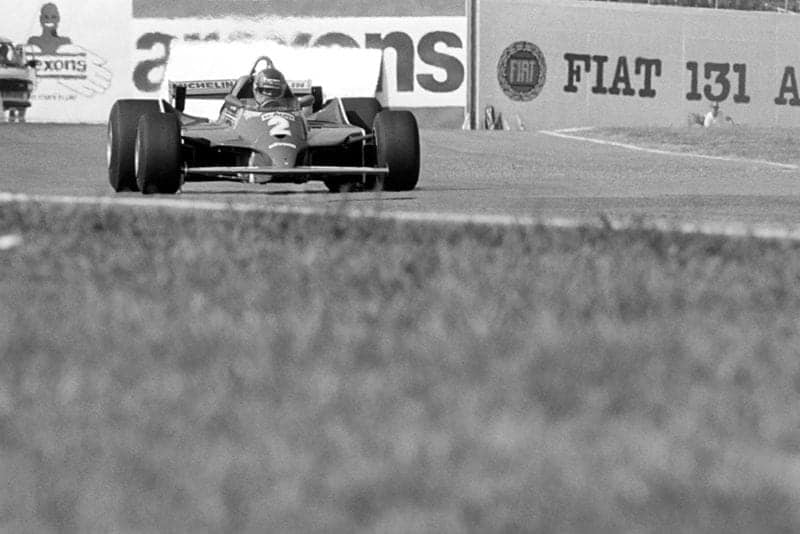
Gilles Villeneuve tested the turbocharged Ferrari 126C on the opening day of practice before reverting to his regular car
© Motorsport Images
By 1 p.m. the sky had clouded over and the air was heavy and sultry, which was just as well for a clear sky would have produced unbearable heat. Alan Jones set off in the spare Williams, all three spare Lotuses were out on the track, Villeneuve was still in the turbo-Ferrari and Scheckter was in his own T5, number 046. The South African charged off and promptly had a monumental crash on the fast bend at the end of the pit straight. The car was reduced to scrap but the driver stepped out unscathed, admitting he had gone too fast, too soon, before the tyres had got up to working temperature. Practice was stopped while the mess was cleared up and Scheckter prepared to set off in the spare T5, number 043. The Renaults were instantly out in front, even though Jabouille only managed six timed laps for he had been forced to take avoiding action when an Ensign got in his way and bent the steering slightly on the Renault, so the car was put back in the garage for a check-over. As he was fastest qualifier of the afternoon at this point and his yesterday time was even faster, there was little need for him to go out in the spare car, which was set-up in the cockpit for little Arnoux anyway. Those immediately behind the Renaults were certainly trying hard and both Jones and Piquet had lurid spins as they drove right to “the ragged edge” and over. Reutemann, Giacomelli and Piquet had got into the 1 min. 34 sec. bracket, which meant they were in with the Renaults, but then Arnoux took the wind out of their sails by turning a lap at 1 min. 33.988 sec., the first and only driver to get below 1 min. 34 sec. Alan Jones changed over to his own car, from the spare, but try as he might he just could not join the elite in the 1.34 group.
Villeneuve did fifteen laps in the turbo Ferrari, with a best lap in 1 min. 35.751 sec. and then switched to his flat-12-cylindered T5, but could not match the time, so everyone at Ferrari was pretty happy with their new car. Just behind Villeneuve was young Hector Rebaque, who got a good “A-for-effort” with a time that gave him ninth place on the grid. For the rest most were where we have become used to seeing them, except for the two Ligier drivers, with Pironi in thirteenth place and Laffite in a lowly twenty-second place, the whole confidence of the team having evaporated and been replaced by panic, so that they got in a worse muddle than ever. Cheever was well pleased with qualifying the new Osella in sixteenth place and dear old Brambilla was comfortably in. Not unexpectedly the two Ensign drivers, Lammers and Lees, were out, as were Winkelhock and Mansell. Formula One is not an easy game to break into if you don’t have the inspired talent of a Villeneuve or a Piquet.
Race
Sunday morning was warming up nicely, a haze over the sun preventing it from burning, but the air temperature was very warm which did not make the tyre and brake people too happy. Some teams, like Williams, were fitting extra large air scoops to the brakes, others like McLaren and Renault were fixing additional air feeds in the form of flexible tubing strapped on to existing ducts. Villeneuve was going to race his flat-12 engined 3-litre, Scheckter was using the muletta and 045 had been brought from Maranello as a reserve. The turbo Ferrari had done its job, of showing where Ferrari was going next year, and had kept faith with the fans. The warm-up, half-hour from ten minutes past midday passed off without major incident and everything outset for the 3 p.m. start. ATS were running their newest car, Osella were running their new one, Piquet was in the latest BT49 Brabham, and Prost in the M30 McLaren. As the cars set off from the pit lane to do an initial lap round to the assembly grid Giacomelli got a terrific reception, as did Villeneuve. Ferrari enthusiasts in the enormous crowd had banners proclaiming “Go Ferrari, we’re still with you” and other said “Forza Bruno” or “Giacomelli con l’Alfa vincere”. A rather poignant banner said “Imola 1, Monza 0”.

Ground effect cars lead the pack at the 1980 Italian Grand Prix
Motorsport Images
The heat in the Autodromo, bounded by concrete walls, was becoming a bit over-powering as we waited for the last five minutes. Rosberg, de Angelis, Cheever, Fittipaldi, Pironi and Reutemann had all sneaked in a second warm-up lap by passing through the pit lane instead of joining the assembly grid. With Alan Jones in a lowly sixth position and Reutemann in third position with a clear run in front of him between the Renaults, it was all down to the Argentinian this time, as far as the Williams team were concerned, but the odds were that Giacomelli would try and jump the lot of them. In orderly fashion all 24 cars followed Arnoux round on the parade lap and you could not help but be impressed at the sight of the two Renaults at the head of the field for the third consecutive race. As the whole field waited for the green light to shine Reutemann over-heated his clutch linings and as he surged away between the Renaults and changed into second gear his clutch slipped madly and everyone dodged round him. Piquet and Giacomelli took advantage of the blockage and were up behind the Renaults and Villeneuve was right with them. The idea that Renaults are slow off the mark is another story that is a thing of the past.
Arnoux led Jabouille on the opening lap with Piquet right behind them followed by Giacomelli (wild cheers from the Alfa fans), then Villeneuve, Rebaque, Jones, Pironi, Jarier, Watson, Andretti, Patrese and the rest. The last three cars to come down the hill on the back of the circuit, into the double left-hand bend taking them back towards the pit area, were Brambilla, Rosberg and Reutemann, all going quite gently, the Williams driver nursing his clutch until it gripped properly again and for some inexplicable reason they literally fell over each other, but all managed to keep going. On lap two there was no significant change and Reutemann was hopelessly last, having “thrown it all out the window” for Frank Williams. Third time round and it was Jabouille leading, but the tenacious Piquet had got between the Renaults and was trying to take the lead. Next time round you could hardly see the Brabham, it was so tucked up under the back of the Renault, and as they accelerated towards the two-ess-bends before the pits it nipped out of the slip-stream and into the lead. While the Piquet followers were grinning contentedly the Ferrari fans were screaming hysterically because Villeneuve had overtaken Giacomelli and the Alfa fans were shouting in dismay.
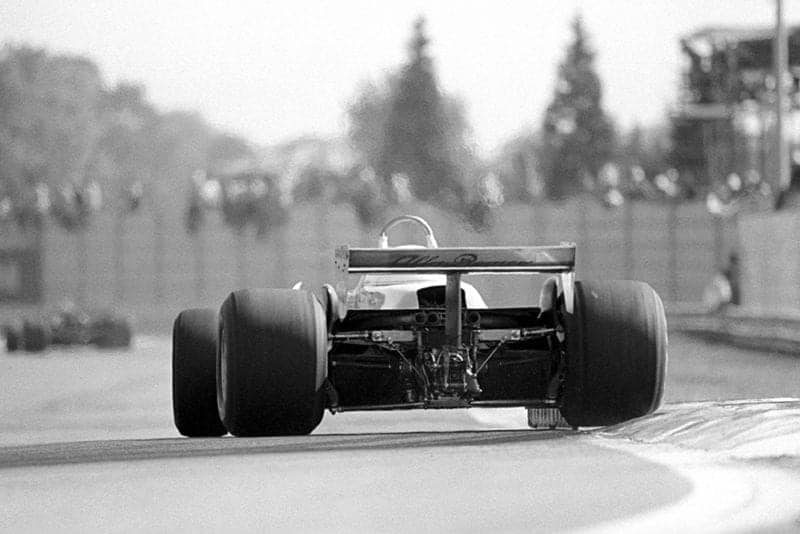
An Alfa Romeo rides the kerb exiting the Variante Alta
© Motorsport Images
After five laps the order was Piquet (Brabham), Jabouille (Renault), Arnoux (Renault), Villeneuve (Ferrari), Giacomelli (Alfa Romeo), Rebaque (Brabham) doing very well, and Jones (Williams). Pironi was leading the mid-field runners, but was already a fair way back, and Reutemann was trailing along at the back now unable to make fourth gear stay in. As the leaders were heading for the tight left-hand hairpin at Tosa, Villeneuve was on full song into the preceding right-hand curve when his left-rear tyre burst. The Ferrari bounced from side to side of the track and the whole rear end of the car was torn off. Giacomelli, who was following narrowly missed the wreckage but ran over the debris and punctured a tyre, which put him off into the scenery as well. It was a bad day for Italy for Brambilla had taken to the rough stuff on the previous lap and destroyed a rear tyre, which flailed round and demolished the rear suspension and the aerofoil, and Scheckter in the remaining truly Italian car was down in thirteenth position. The animation amongst the Ferrari and Alfa fans was destroyed in one move and all they could do was watch the confident Nelson Piquet draw away from the opposition. Jones had scratched past Rebaque and though he was now fourth with the retirement of Villeneuve and Giacomelli, he had lost touch with Piquet and did not look like regaining it. Villeneuve was very lucky to step out of the wreckage unscathed and Giacomelli was a bit shaken by it all.
Laffite was running in an unhappy position between Scheckter and Keegan and on lap 8 he spun at the foot of the hill, was missed by those immediately behind but as he gathered himself together he elbowed poor old “auntie” Reutemann off onto the dust in a most unruly fashion. Arnoux was in trouble with a rear shock-absorber playing up and had to succumb to pressure from Jones and Cheever was now running last after a quick pit stop to cure an oil leak on the new Osella. Reutemann had now decided how to drive the circuit without using fourth gear, and began to get a move on, passing Daly and Surer and then Prost and de Angelis, but the race was a third run before he did that. By 15 laps it was really all over for Piquet was out on his own, Jabouille was an unchallenged second, Jones an unchallenged third and Arnoux was being harassed by Rebaque. Then came Jarier leading Watson and Andretti, Pironi on his own, Patrese equally alone, Scheckter followed by Keegan and Fittipaldi with Rosberg about to join them. At the end of lap 18 Keegan, Fittipaldi and Rosberg were in a tight bunch, too close for any of them to be strictly on the correct line and the result was that Fittipaldi crossed the bad bumps on the last left-hander before the straight up to the pit area, slightly off-line and a bit askew. Instantly the yellow car bounced out of control and spun off to the outside of the corner and hit the guard rails travelling backwards, which put it out of the race. Marshals wheeled it out of harm’s way while Fittipaldi wondered just what had happened. In trying to pass Arnoux’s Renault Rebaque got off course and damaged the suspension of his Brabham and then Watson got all crossed-up on his own as a rear wheel bearing broke up on his McLaren; he limped back to the pits to retire.
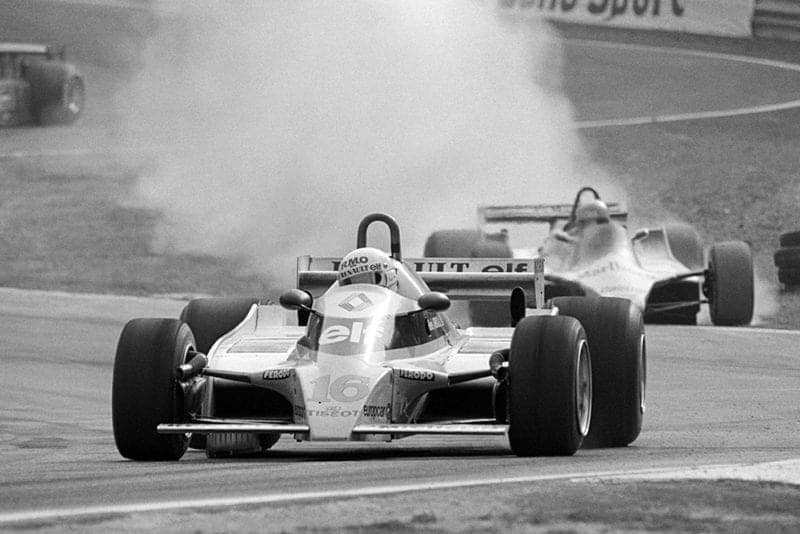
Rene Arnoux leads an off-road John Watso
© Motorsport Images
Slowly but surely Jones was gaining on Jabouille’s Renault, but he was not making any serious inroads into Piquet’s lead and at exactly half distance the Williams moved into second place. A long way back, in fourth place, Arnoux was fending off attacks from Jarier and Andretti, the three of them running in excitingly close company. Reutemann seemed to be stuck behind Rosberg for an awfully long time and Piquet was lapping the tail-enders as if they were not there. On lap 34 Derek Daly had a moment of inattention and ran ever so slightly wide on the last left-hander, where the racing-line had thrown up a carpet of “marbles”. Instantly the Tyrrell under-steered straight on, spun on the grass verge and hit the barriers with a sickening thud almost exactly where the Fittipaldi had crashed. The Tyrrell was not driveable or wheel-able so a huge mobile crane reached over the wire mesh fence and lifted the wreckage off the circuit. Daly was unhurt. Although Jarier and Andretti passed and repassed neither of them could get by Arnoux and on lap 41 the Lotus coasted to a stop with a dead engine, leaving Jarier still trying desperately to get by the Renault. Patrese had dropped out and Reutemann had got past Rosberg at long last and then got past Pironi, so with Andretti’s retirement he found himself sixth. He now had another problem to add to his sorry tale of woe for a piece broke off an exhaust manifold pipe and lost him quite a lot of power, but to balance this he had discovered that fourth gear was all right after all! Piquet was now not far behind the number two Williams with the likelihood of lapping it, but Reutemann at last got wound up and closed on the Arnoux/Jarier dice. This in itself was not going too well for Arnoux’s defective shock-absorber had come adrift and Jarier’s brakes were fading; not from wear but due to a fluid leak in the system to the rear ones. For a glorious moment on lap 47 the Tyrrell driver got ahead, but then the brake pedal feel got worse and he dropped back again and Reutemann went by both the Tyrrell and the Renault. Jones was also in brake trouble as one of the calipers was too close to the disc and the fluid was boiling which produced a spongy feel to the pedal. He had made up some ground on the flying Piquet, but the dark-eyed Brazilian had it all well weighed up. The Brabham BT49 was running perfectly and Piquet bad it in the bag all the time, driving fast and neatly, with coolness and confidence, winning the way he had in Long Beach and at Zandvoort, Jabouille lost a certain third place when his gearbox broke with six laps to go and this let Reutemann inherit third place. Jarier struggled valiantly with his lack of brakes, but had to give it best with only five laps to go, after a praiseworthy battle. Poor Arnoux could only creep to the finish with his disabled Renault, dropping to tenth place.
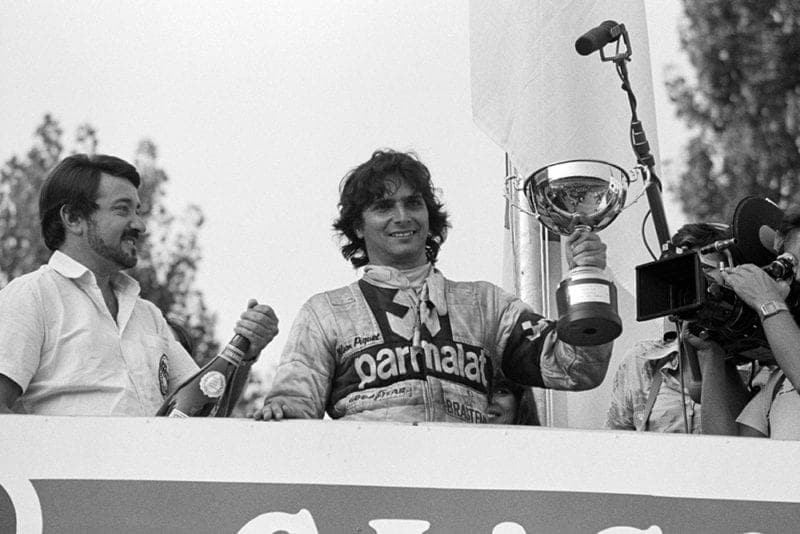
Piquet celebrates a fourth win of 1980
© Motorsport Images
On paper the second and third places to the Williams team looked pretty good, but in reality it was a poor performance relative to what they should have done. The Brabham team had other good reason to feel more than satisfied with their driver, their car and their preparation. Behind the first three was a row of mixed feelings, the other nine finishers being either unimpressive or unfortunate. — D.S.J.
